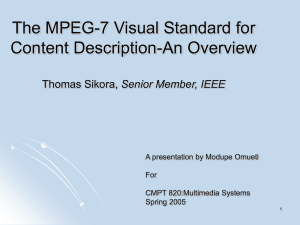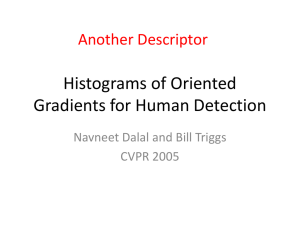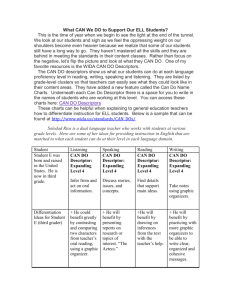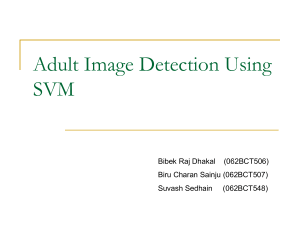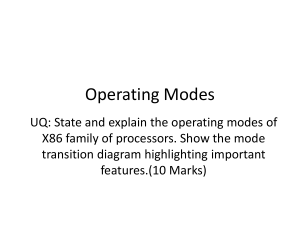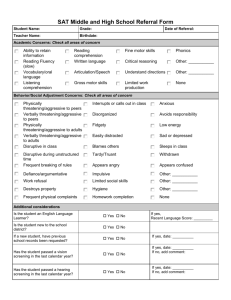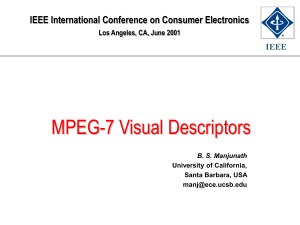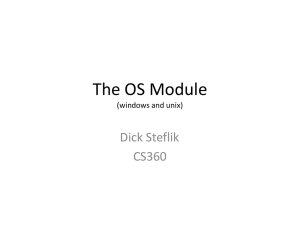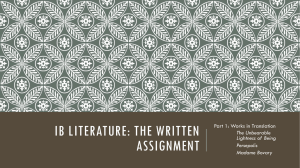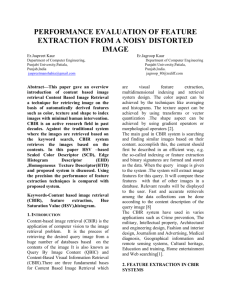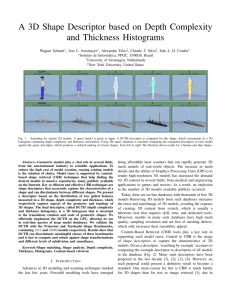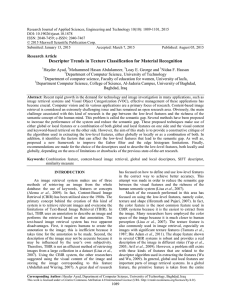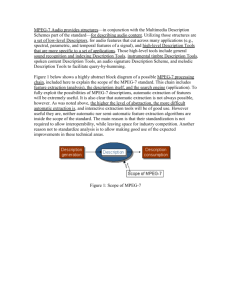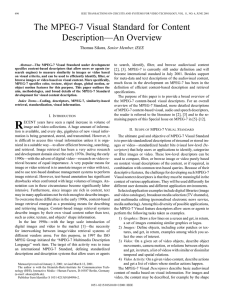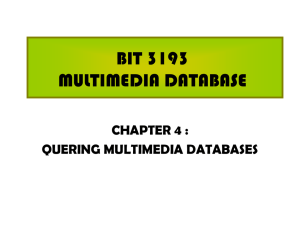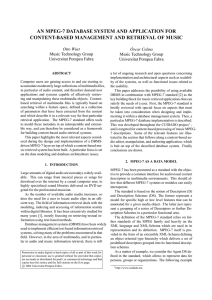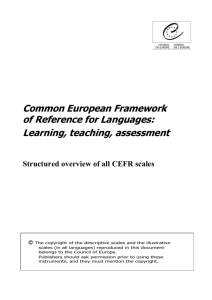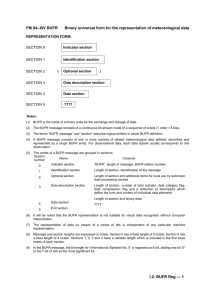the Presentation
advertisement
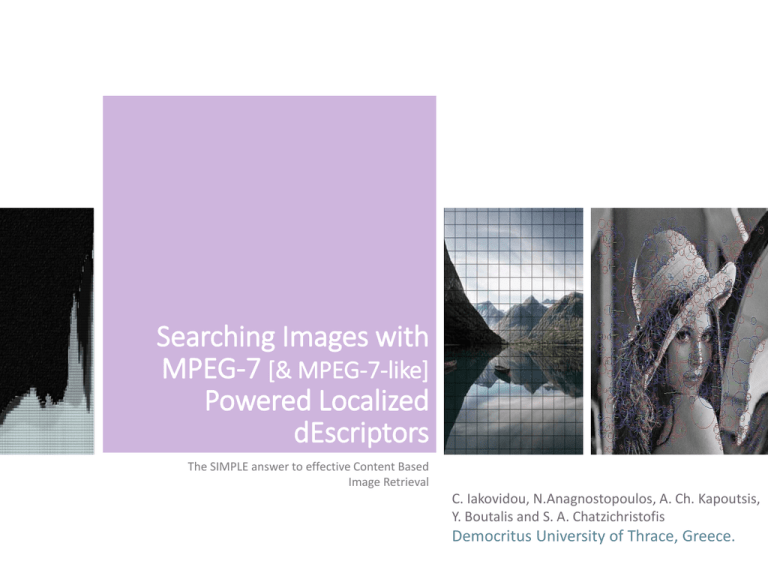
Searching Images with MPEG-7 [& MPEG-7-like] Powered Localized dEscriptors The SIMPLE answer to effective Content Based Image Retrieval C. Iakovidou, N.Anagnostopoulos, A. Ch. Kapoutsis, Y. Boutalis and S. A. Chatzichristofis Democritus University of Thrace, Greece. presentation outline Why? How? Worth it? what type of features form an efficient descriptor provide core technical implementation details experimental results global vs local features evaluation advantages experimental set-up limitations motivation 2 the SIMPLE idea the battle of global vs local features for CBIR tasks MainDisadvantages Advantages Main Global features vs Local features What is considered “similar”? • What does the user rate as effective image retrieval? • How should we vectorize the features he’s looking for? • Should we look further for new techniques? 3 the SIMPLE idea motivation and related work (aka so many methods, so little time) Revisit well established methods from both major image description tactics (global features – local features). Mix and match. Take a fresh outlook on original thoughts, combine and test strategies based on what we know today about retrieval systems. Simplify! Produce and test the new descriptors in a straightforward fashion, so we can get some insight on what works together and what doesn’t. 4 the SIMPLE family of descriptors 5 the SIMPLE family implementation strategy • Images are meaningful when discriminating foreground from background. • Localized texture information is essential • Localized color information highly boost retrieval performance • Image features need to be quantized for faster vector distance measurements • Compact overall representations. All edges Texture and Color are not orthogonal properties All reds All blues All uniform 6 the SIMPLE family implementation details (POI detection) • Employ the SURF detector • Utilize achromatic information • Locate salient image patches of blob-like structures in multiple scales using the Hessian matrix and integral images. 1. Detecting Salient Image patches 1. Robustness to image transformations 2. Fast execution 3. Easily adapted to parallel processing since each Hessian image can be independently generated 7 the SIMPLE family implementation details (POI description) We obtained image patches from the whole collection where we know something “interesting” is happening texture wise. (blob-like responses) 2. Describing Salient Image patches Without actually vectorizing these responses we employed: • two color based descriptors (MPEG-7 SCD, CLD) • one edge based descriptor (MPEG-7 EHD) • one descriptor that combines color and texture information (MPEG-7-like CEDD) 8 the SIMPLE family implementation details (POI description) MPEG-7 Scalable Color Descriptor is a color histogram in a fixed HSV color space achieved through a uniform quantization of the space to 256 bins. An encoding step istn e ic f o s a w p Lperformed by a Haar transform, for compression. Then, (s 1 e lu a v in B + )a number of m u ) a coefficients is used to + represent the descriptor. Its 2 e u l a v n i B t n f e o c s a p h ig H representation is scalable in terms of bin numbers + ) e c n r f id ( and bits used for accuracy. We followed the default proposed setting of 64 coefficients. r a H ++ +- ++ ++ ++ ++ + +- - +++- + ++- ++ . . ++ +- ++ +- +- ++ - + +- - g n ila c S + + +++- +++- Nonliear 25oumstv6glHaeri ... ++ - . b ) uantizoQ . ... Quantizo raenLi ... +++- ts n ic f e o C 16 32 64 128 256 m r o f s n a T 9 the SIMPLE family implementation details (POI description) MPEG-7 Color Layout Descriptor The descriptor represents the spatial distribution of the color in images in a compact form. The image is divided into (64) 8 x 8 discrete blocks and their representative colors in the YCbCr space are extracted. The descriptor is obtained by applying the discrete cosine transformation (DCT) on every block and using its coefficients. The produced descriptor is a 3 x 64 bin (64-Y, 64-Cb, 64-Cr) representation of the image 10 the SIMPLE family implementation details (POI description) MPEG-7 Edge Histogram Descriptor The descriptor represents the spatial distribution of five types of edges in the image. A given image is first subdivided into 4 x 4 subimages, and the local edge histogram of five broadly grouped edge types a) vertical b) horizontal c) 45 degree (vertical, horizontal, 45 diagonal, 135 diagonal, and edge edge edge isotropic) is computed. Each edge histogram consists of five bins (one for every edge type). An image subdivided in 16 blocks produces an 80-bins edge descriptor. a) vertical b) horizontal c) 45 degree d) 135 degree e)non-directional edge edge edge edge d) 13 ed edge 11 the SIMPLE family implementation details (POI description) MPEG-7-like Color Edge Directivity Descriptor CEDD is originally a global descriptor that divides an image into 1600 rectangular image areas. Those Image-Blocks are then handled independently to extract their color information (through a two staged Fuzzy Histogram Linking procedure that produces a 24-bin color histogram of pre-set colors) and texture information (employing the five digital filters proposed by the MPEG-7 EHD and using a heuristic fuzzy pentagon diagram to threshold the normalized maximum responses so as to form a 6- bin texture vector). The obtained vectors are combined in the end to form the 144 bins CEDD descriptor. 12 the SIMPLE family implementation + Detect regions in multiple scales, that are interesting texture-wise + Describe them with 4 different global-features’ methods + Produce 4 new local features for Image retrieval: SIMPLE-SC, SIMPLE-CL, SIMPLE-EH, SIMPLE-CEDD All compact and quantized 13 testing the SIMPLE descriptors for image retrieval 14 the SIMPLE family retrieval system Bag-of-Visual-Words framework 1. Extract the SIMPLE local features 2. Forward 15% to K-means classifier 3. Prepare the codebooks (32, 128, 512, 2048) 4. Assign VW to all images 5. Employ 8 tf.idf weighting schemes 6. Perform retrieval, ranking results based on the lowest Euclidean distance 15 experimental set-up image collections, codebook sizes, evaluation metrics UKBench Image Collection • • • • Consists of 10200 images arranged in 2250 groups of four images per group. Each group includes depictions of a single object. Local features are Only images of the same group are considered reported to relevant. perform better The first 250 images of the first 250 groups were used as queries. UCID Image Collection • • • • Consists of 1338 uncompressed Tagged Image File (TIF) format images. It covers a variety of topics, including natural scenes and man-made objects. Manual relevance assessments among all database images are provided. the ground truth consists of images with similar visual concept to the query image. Global features are reported to perform better 16 experimental set-up image collections, codebook sizes, evaluation metrics Evaluation Metrics Codebooks Four different codebook sizes • 32 VW, • 128 VW, • 512 VW, • 2048 VW • Mean Average Precision (MAP) (max at 1) • MPEG-7 Average Normalized Modified Retrieval Rank (ANMRR) (max at 0) • Precision-at-K (P@K) (max at 1) P@4 (UKBench) P@10 (UCID) Total Number of experiments • Local features (SURF, SIFT, ORB, BRISK, Oppo. SIFT) (4 SIMPLE + 5 LFDescr) x 4 codebooks x 8 weighting schemes= 288 • Global features 7 GFDescr Total of 295 x 3 evaluations= 885 retrieval evaluations 17 experimental results UKBench Image Collection SIMPLE-SC, outperforms all other local and global descriptors for 3 out of 4 codebook sizes. SIMPLE-CEDD and SIMPLE-CL also showed consistent high performance. SIMPLE-EH did not produce the desired results in this collection for Our best performing any codebook size. improves SIMPLE descriptor • MAP by 12% • P@4 by 16% and • ANMRR by 53%. 18 experimental results UCID Image Collection The proposed SIMPLE-CEDD, SIMPLE-SC and SIMPLE-CL descriptors all outperform the next best reported descriptor. Great results even with tiny 32 VW codebook SIMPLE-EH seems to perform slightly better in this collection but still fails to even improve the SIMPLE-CEDD and SIMPLE-SC original global EHD or SURF increase descriptors that it emerged from. • MAP by 14%, • P@10 by 12% and • ANMRR by 30%. 19 conclusions and discussion contribution, applications, open issues • Four novel descriptors were presented in this paper and were tested in the most straightforward fashion to provide some insight on retrieval requirements. • We believe SIMPLE-SC and SIMPLE-CL were successful because they provide color information with textural attention. • SIMPLE-CEDD which has both local color and texture information also performs exceptionally good. Its quantization stages produce retrieval-friendly image representations. • Some limitations concern image/patch sizes, image collection properties and the generation of the appropriate codebook • Further experiments must be conducted on different collections along with comparisons to more local features to draw solid conclusions • The descriptors are easy to implement, present high retrieval performance and can be adopted as local features in many other more sophisticated retrieval systems. 20 source code available in C#, Matlab and Java http://tinyurl.com/SIMPLE-Descriptors Also included in open source library for CBIR 21 Thank you! This research has been co-financed by the European Union (European Social Fund – ESF) and Greek national funds through the Operational Program "Education and Lifelong Learning" of the National Strategic Reference Framework (NSRF) Research Funding Program: Heracleitus II. Investing in knowledge society through the European Social Fund.
